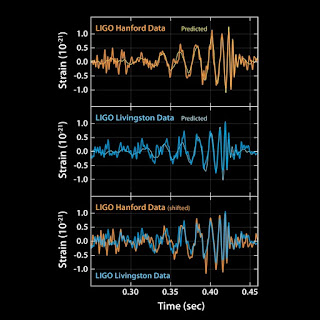I never post on here except when my non-physicist friends ask me to explain something, and then I actually get the motivation to write it up. It's really funny that my last post, from over a year ago, was on the same topic. Now LIGO just released their results on a direct observation of gravitational waves!
On Fri, Feb 12, 2016 at 10:33 AM Gaetano Mina wrote:
Aggle please ELI5 the gravity physics discovery which is allegedly the biggest science deal of the decade.
Thanks.
(For the record, ELI5 means "Explain like I'm 5")
My response:
"Gravity
waves" were something that was predicted a hundred years ago, and we've
been looking for them ever since! The story of their prediction is kind
of funny. Einstein came up with general relativity, but it was someone
else who used it to predict that general relativity allowed "gravity
waves" to exist. Einstein made some calculations and was all like "no
you're wrong, waves are not possible" but he had made a mistake - and
when he tried to publish this, the journal was like "bro u messed up"
and he was like "no u" and got super pissed off and boycotted them for
the rest of his life.
OK, so back to what's
going on - If you swish your hand around in a circle in a pool of water,
you'll make a spiral wave going out. This is basically what happens with
the black holes that are orbiting each other, with the "water" in this
case being spacetime itself. The wave itself is kind of weird - it's a
compressed region of spacetime itself that's moving out from the
orbiting black holes. You can sort of see what this looks like if you
take a slinky and push it back and forth. This was the best video I
found of that:
https://www.youtube.com/watch?v=ubRlaCCQfDk
This
is where the actual measurement gets even weirder - since it's
spacetime itself that is changing shape, you can't measure changes with
anything made of matter, because that changes size too. The only thing
you can use is light, since the speed of light is always constant. This
means they had to use a really, really long laser beam and measure the
time it takes for the laser to return after bouncing off of a mirror.
Since the speed of light is always the same, it isn't affected by the
ripple in spacetime that's passing through the detector.
Next,
these lasers are built here on Earth, and they're super sensitive, so
they pick up movement like earthquakes, trees falling, and lots of other
stuff that you don't care about, so somehow the LIGO people had to find
a way to separate the gravitational wave signal from all this noise.
They picked something that's really unique - the exact moment when the
black holes spiral in faster and faster and faster and then merge.
That's what they show in these plots here:
It turns out that the frequencies are actually in the normal range of human hearing, so we can make a sound out of them!
https://soundcloud.com/emily-lakdawalla/ligochirp - this is the sound of two black holes merging.
People are getting pretty excited about trying to chirp like LIGO.
So
from 1.3 billion light years away, we caught the final moments of a
black hole merger and confirmed a hundred-year-old consequence of
general relativity that had never been seen before.

1 comment:
Thanks...maybe next time ELI3 :) I am happy you are excited!
Post a Comment